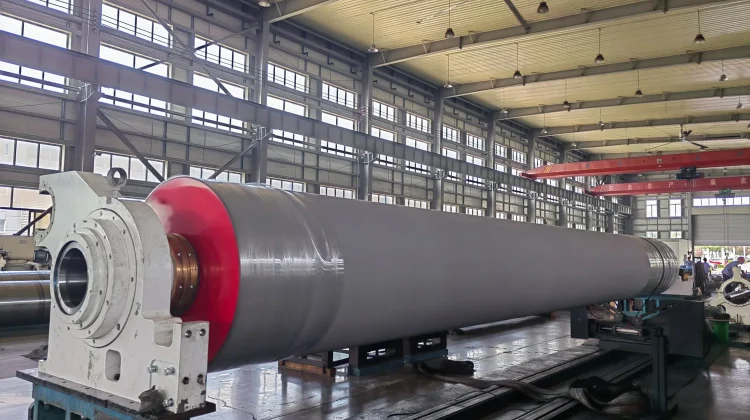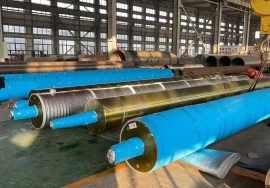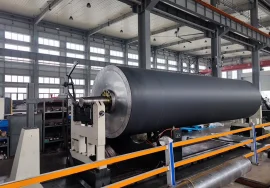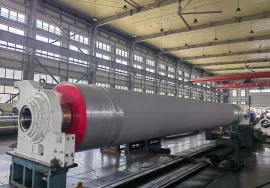
Introduction
Paper mill rolls are the unsung heroes of the papermaking process, playing a pivotal role in determining the efficiency, quality, and longevity of paper production lines. From suction press rolls to calender rolls, these components directly impact dewatering, surface smoothness, and overall machine performance. In this comprehensive guide, we explore the types, materials, applications, and maintenance strategies for paper mill rolls, offering actionable insights for paper mill engineers, procurement managers, and industry professionals seeking to optimize their operations.

paper mill rolls
Understanding Paper Mill Rolls: The Backbone of Papermaking
Paper mill rolls, also known as paper machine rollers, are cylindrical components integrated into various sections of a paper machine, including the wet end, press section, and drying section. Each type of roll serves a specific function, such as removing water from the pulp, pressing the paper web, or enhancing surface properties. With modern paper machines operating at speeds exceeding 2000 meters per minute, the demand for high-performance rolls has never been greater.
The choice of roll type, material, and maintenance strategy can significantly affect production efficiency, paper quality, and operational costs. For instance, advanced suction press rolls with duplex stainless steel shells can enhance dewatering efficiency, while calender rolls with polymer coatings ensure superior surface smoothness for high-quality printing papers.
Types of Paper Mill Rolls and Their Applications
1. Suction Press Rolls
Suction press rolls are critical in the press section of a paper machine, where they remove water from the wet paper web through a vacuum system. These rolls feature perforated shells, often made of duplex stainless steel, with precise hole positioning to maximize dewatering efficiency.
-
Key Features:
-
Support high-speed operations (>2000 m/min).
-
Available with rubber or polyurethane covers for enhanced durability.
-
Ideal for newsprint, tissue, and packaging paper production.
-
-
Case Study: Hamburger Hungaria upgraded to Valmet’s pick-up suction rolls, reducing unplanned downtime by 30% and extending roll life by three times.
2. Plain Press Rolls
Plain press rolls, typically used in combination with suction rolls, apply mechanical pressure to remove water and consolidate the paper web. These rolls are often paired with press felts to optimize dewatering and extend felt life.
-
Key Features:
-
Upper rolls are commonly made of granite or synthetic stone for smoothness.
-
Lower rolls feature rubber-coated cast iron for flexibility and durability.
-
Suitable for standard and positive-pressure press configurations.
-
-
Application: Widely used in kraft paper and board production, where consistent pressure is critical.
3. Calender Rolls
Calender rolls are employed in the finishing section to enhance the paper’s surface properties, such as gloss and smoothness, which are essential for printing and packaging applications. These rolls operate under high pressure and temperature, requiring robust materials like chilled cast iron or advanced polymers.
-
Key Features:
-
Deflection-compensated designs ensure uniform pressure distribution.
-
Polymer coatings reduce vibration and improve surface quality.
-
Critical for high-quality coated papers and specialty grades.
-
-
Trend: The adoption of soft calender rolls with heated surfaces is growing, as they offer superior gloss without compromising paper strength.
4. Other Specialized Rolls
-
Breast Rolls: Located at the forming section, these rolls guide the pulp slurry onto the forming fabric. Modern designs, such as grooved breast rolls, improve formation and drainage.
-
Dryer Rolls: Used in the drying section, these rolls are typically steam-heated and made of cast iron to withstand high temperatures.
-
Guide Rolls: Ensure proper web alignment and tension throughout the paper machine.
Material Selection for Paper Mill Rolls
The choice of material for paper mill rolls directly impacts performance, durability, and maintenance costs. Common materials include:
-
Duplex Stainless Steel: Used in suction rolls for corrosion resistance and precise hole positioning. Ideal for high-speed and high-moisture environments.
-
Rubber and Polyurethane Covers: Applied to press rolls to enhance grip, reduce wear, and extend felt life. HEXPOL’s rubber compounds, for example, offer excellent abrasion resistance.
-
Granite or Synthetic Stone: Preferred for plain press rolls due to their smooth surface and resistance to deformation.
-
Chilled Cast Iron: Common in calender and dryer rolls for its ability to withstand high temperatures and mechanical stress.
-
Polymer Composites: Increasingly used in modern rolls for their lightweight properties and resistance to chemical degradation.
When selecting materials, consider the paper type (e.g., tissue vs. board), machine speed, and environmental factors like humidity and chemical exposure. For instance, polyurethane covers are ideal for high-load, non-water-cooled press sections, while granite rolls excel in low-speed applications.
Maintenance Strategies for Longevity and Performance
Proper maintenance of paper mill rolls is essential to minimize downtime, extend roll life, and ensure consistent paper quality. Here are key strategies:
-
Regular Inspections: Check for wear, surface cracks, and hole blockages in suction rolls. Early detection prevents costly repairs and production losses.
-
Cleaning and Lubrication:
-
Wet end rolls: Use grease-based lubrication to protect against moisture.
-
Dry end rolls: Implement oil circulation systems for high-temperature environments.
-
-
Roll Regrinding: Periodically regrind roll surfaces to restore smoothness and remove wear patterns. For example, rubber-covered rolls should be reground every 6-12 months, depending on usage.
-
Use OEM Parts: Avoid non-compatible parts, which can accelerate wear or cause misalignment. Partner with trusted suppliers for precision-engineered components.
-
Alignment and Balancing: Ensure rolls are properly aligned to prevent vibration and uneven wear. Dynamic balancing is critical for high-speed operations.
Pro Tip: Implement predictive maintenance using sensors to monitor roll vibration and temperature, allowing for proactive repairs before failures occur.
Industry Trends and Innovations
The paper mill roll industry is evolving rapidly, driven by demands for higher efficiency, sustainability, and customization. Key trends include:
-
Shoe Press Technology: Shoe press rolls, with their wide nip zones, are revolutionizing dewatering efficiency, allowing for faster production and reduced energy consumption. For example, Andritz’s shoe press rolls can increase dry content by up to 5%.
-
Sustainable Materials: Manufacturers are adopting eco-friendly materials, such as recyclable polymer covers and low-energy coatings, to align with global sustainability goals.
-
Digital Integration: Smart rolls equipped with IoT sensors provide real-time data on performance metrics, enabling predictive maintenance and reducing unplanned downtime.
-
Customization: Suppliers like Qinyang Aotian offer tailored roll designs, with lengths up to 12 meters and weights up to 100 tons, to meet specific paper machine requirements.
Choosing the Right Paper Mill Rolls for Your Operation
Selecting the optimal rolls depends on several factors:
-
Paper Type: Newsprint requires high-permeability felts and suction rolls, while board production demands heavy-duty press rolls for thicker webs.
-
Machine Speed: High-speed machines (>1500 m/min) require deflection-compensated rolls and durable coatings to withstand stress.
-
Budget and ROI: Balance initial costs with long-term benefits, such as reduced maintenance or improved paper quality. For example, investing in polyurethane-covered rolls can lower felt replacement costs.
-
Supplier Expertise: Partner with suppliers offering technical support, customization, and rapid-response aftermarket services.
Case Study: A Scandinavian paper mill switched to Valmet’s grooved breast suction roll shells, achieving a 20% increase in drainage efficiency and a 15% reduction in energy costs.
Conclusion
Paper mill rolls are critical to achieving high-efficiency, high-quality paper production. By understanding the types, materials, and maintenance strategies, paper mills can optimize performance, reduce costs, and stay competitive in a rapidly evolving industry. Whether you’re upgrading suction press rolls or exploring innovative shoe press technology, choosing the right rolls is an investment in your operation’s success.
For premium-quality paper mill rolls and customized solutions tailored to your paper machine, visit our website to explore our full range of products and services.




